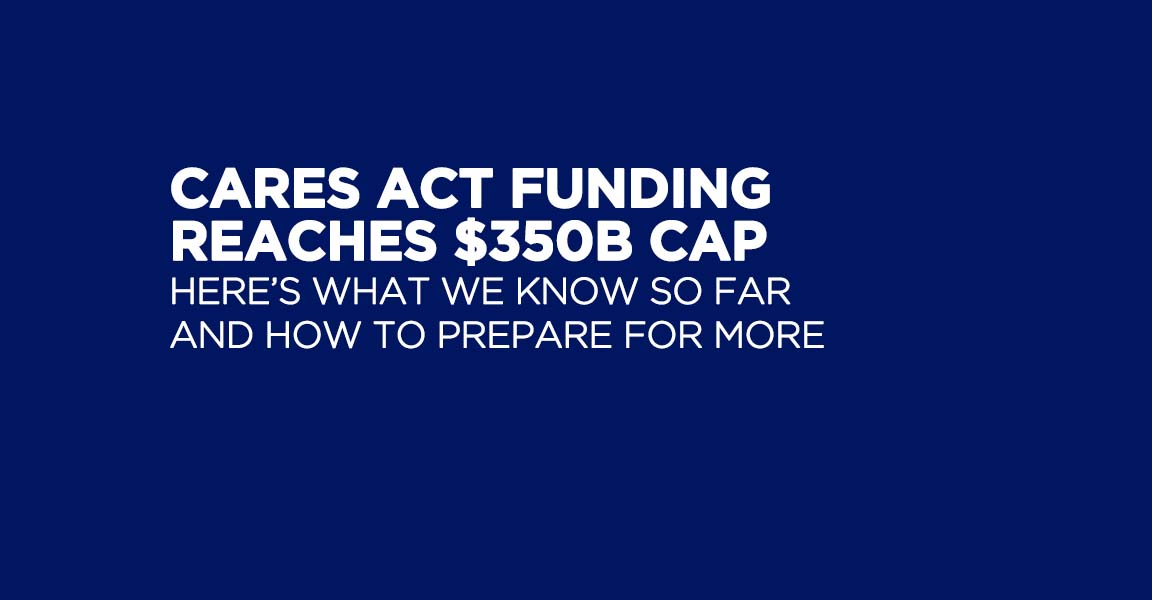Adjusting Online for Nonprofits: Keeping Faith Alive
April 11, 2020
Nonprofit PPP Loan Program Reaches $350 Billion Cap – April 17, 2020
April 16, 2020Nonprofit Answers to COVID-19 Questions – Jack Horak

Nonprofit Answers to COVID-19 was written by Jack Horak who proposes that the CORONAVIRUS allows nonprofits to ponder two related questions:
First, how will the crisis affect existing nonprofits?
Second, how will it reshape the charitable sector?
The first question is easy. Weaker nonprofits will fail, and stronger ones will survive. It’s a tough thing to say but it’s true, and candidly, in my experience the failure of an entity does not mean the mission works ends — it just gets picked up by other more capable organizations.
As to the future landscape, the most I will venture at this early stage is that it will be more challenging post-crisis than it was pre-crisis, so even nonprofits which survive will need to work harder and smarter to navigate the new environment and, most importantly, to stay financially strong.
Nonprofit Answers to COVID-19
I acknowledge that “harder and smarter” and “financially strong” are vague terms – so to help unpack them I decided to express my thoughts in the form of the following six operating principles. Some of these principles may seem mundane (not to be new), but they are all here for a reason – and some of what I say flies in the face of sector orthodoxy. I invite critical commentary and suggestions.
Principle one: Understand the nature of the board of directors. The buck always stops with the board of directors as a matter of law. The board of directors has ultimate legal power over and responsibility for the assets and affairs of the organization. The most important things a person brings to a board are talent, experience, ideas, and a willingness to work hard. A hard-working talented board member who cannot afford to make a personal contribution is more valuable than a lazy and inattentive board member who writes a large check each year. In appropriate cases a nonprofit should consider professionalizing the board by paying director fees to attract the necessary talent. See my 2018 inside Charity Article “Time to Take off the Stupid Hat” at: https://insidecharity.org/2018/08/02/nanoe-boards-john-horak/. While the board is at the top of the chain of command, its operations are subject to the practices and limitations in Principles Two and Three below.
Principle Two: Understand the delegation of authority and the component parts of your operating system. Notwithstanding the ultimate authority of the board, its members are not expected to be involved in, and should not be involved in, the day to day operations of the organization. The power and responsibility for operations are delegated from the board of directors to “management” (see principle Three), and then delegated down the chain of command from management to rank and file operating employees or staff.
The board of directors, management, and general staff are separate and distinct components of the operating system; and each component should understand its separate and proper role, respect the roles of other components, and not (except in extraordinary circumstances) interfere with or usurp the duties of the other components.
The delegation of operating functions down from the board of directors to others does not relieve the board from ultimate responsibility for the results of operations of the organization in the hands of the people to whom authority is delegated (See Principles Three and Four).
Principle Three: Never forget the line that separates the board from management. A primary function of the board of directors is to hire the people who operate the organization in the ordinary course of business and who are a part of “management.” “Management” consists of individuals who are employed by the organization, and typically have titles such as CEO, President, Chief Operating Officer, Chief Financial Officer, Vice President, and the like. These individuals have duties commensurate with their titles and are answerable to the board of directors for their performance. Management hires, fires, and supervises rank and file employees.
The board should, every year, give clear direction of its expectations for management and review management’s performance relative to the expectations, but should not micro-manage or unduly interfere with management. Well drafted employment contracts with the most senior members of management are recommended because they define the duties and relationship and provide guidelines to follow in the event of termination. Except in unusual circumstances, members of management should not be on the board of directors and vice versa. The “board-management” distinction is vital to the understanding of financial reporting obligations (Principle 4).
Principle Four: Understand the Role of Outside Auditors. Most operating nonprofits are required by law or contract to undergo an annual financial audit. The audit is conducted by licensed professionals (Certified Public Accountants) in accordance with standardized accounting principles. The audit is like a financial report card and typically is distributed to government agencies, lenders, funders, donors and others outside the organization.
Remember and understand that the principle task of the auditor is to opine on a completely disinterested basis on the financial condition and results of operations of the organization as conducted by management and based on information the auditors obtain from management. The board of directors should meet at least annually with the auditor to review the organization’s financial statements and performance without management present in the room and should also use the results of the audit and the meeting with the auditors to review management’s performance formally. If any member of management is not doing his or her job they should be replaced.
Principle Five: Be a prudent steward of and maximize the organization’s assets and wealth. The assets of a nonprofit organization include cash and investments, tangible property such as buildings, vehicles, equipment and supplies, intangible assets such as logos, manuals, protocols and systems, and, importantly, the organization’s good will or reputation. All these assets should be maintained and managed with care and prudence, as appropriate.
The board should reject historical and cultural connotations that arise from the “non” that appears before the word “profit,” and from the practice of associating charity and poverty with virtue and profit (wealth) with vice. These connotations have an adverse effect on the mission by suggesting to boards, management, and outsiders that nonprofits can and should do everything “on the cheap” (especially management compensation) — when in fact the opposite is true.
Accordingly, a primary obligation of the board of directors is to make sure the organization it serves is well-capitalized – that it operates with a surplus and maintain a system that regularly and sustainably attracts capital from an identified curated base of donors. The board should delegate the performance of fund-raising tasks directly to executive level management (Principle Three) but should monitor fund raising performance and assist when called upon to do so.
Principle Six. Beyond charity and compassion – recognize the 21st century operating reality.
Modern operating organizations have much more in common with businesses than they do with “charities” as that term has been traditionally defined and used over the past 200 years or so.
Modern nonprofits are complex enterprises with many moving parts behind the scene (such as purchasing, logistics, contracting, and risk management). The talent needed to keep the parts moving in a synchronized manner is business talent – not clinical front-line talent.
A nonprofit should be financially strong enough to offer wages and benefits competitive enough to attract first rate individuals to fill these operating positions – as well as to attract the best possible clinical or programmatic talent.
Charity and compassion are too subjective and laden with unhelpful historical connotations to function as the first or primary governance principle for modern boards and management teams. These terms have an important, but subordinate place in boardroom and management discussions.
Let me close by inviting responses, criticism, and suggestions so that I can continue to develop and refine, and if necessary correct, these thoughts.
Nonprofit Answers to COVID-19 – TWO QUESTIONS BY JACK HORAK was first posted at NANOE NEWS
For more articles like Nonprofit Answers to COVID-19 – TWO QUESTIONS BY JACK HORAK VISIT HERE
Jack Horak and TANGO Alliance are members of National Association of Nonprofit Organizations & Executives
The post Nonprofit Answers to COVID-19 – TWO QUESTIONS BY JACK HORAK appeared first on NANOE | Charity’s Official Website.
